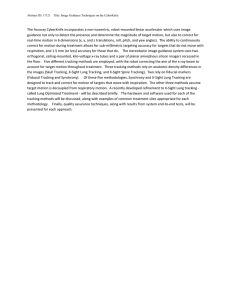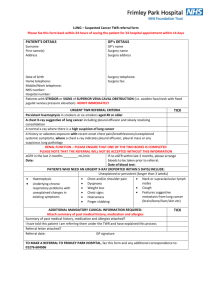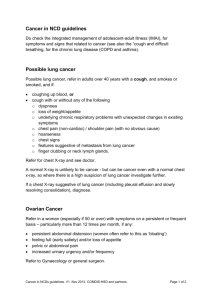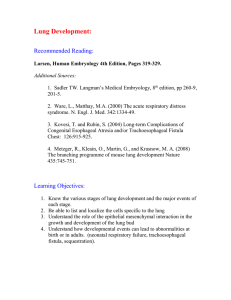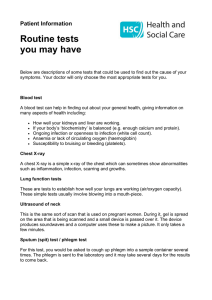Early Detection of Lung Cancer
advertisement
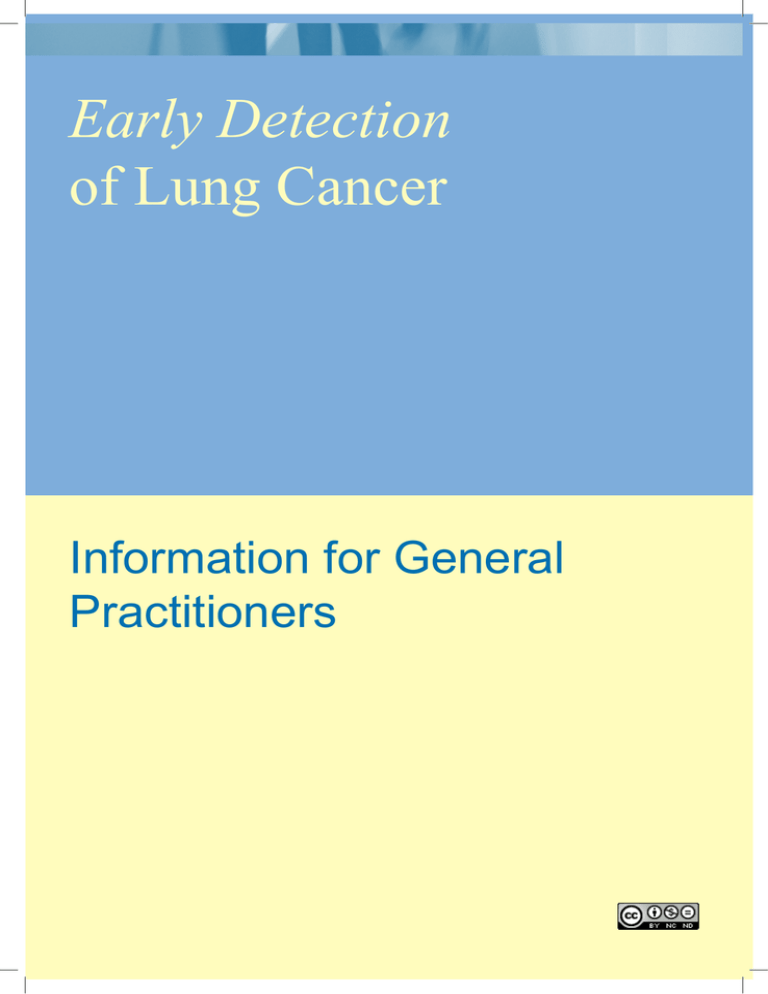
Early Detection of Lung Cancer Information for General Practitioners Produced By Clare de Normanville Principle Consultant Angela Tod Principle Research Fellow Samantha Jewell Senior Lecturer Elaine Brookes Principle Consultant Claire Hannah Learning Technologist Luke Miller Learning Technologist Disclaimer “The information herein is based on data and legislation current at the time of its production and whilst the University has exercised all due care and skill in the preparation thereof it cannot accept any responsibility for any errors or omissions herein including but not limited to those resulting from changes in legislation.” Faculty of Health & Wellbeing Sheffield Hallam University 1 Introduction Guidance from the National Institute for Clinical Excellence or NICE advises that: Someone who • has a new and persistent cough for more than 3 weeks • develops breathlessness • has blood flecks in their phlegm Mr Smith is in again asking for antibiotics and something for that cough. should see a doctor and ask for a chest X-ray. There is a current concern that many people with lung cancer are not getting a diagnosis early enough to get curative or effective treatment. Reducing rates of lung cancer and improving diagnosis and treatment of people with lung cancer are priorities for Doncaster. To tackle the problem a social marketing initiative has been developed jointly by members of Doncaster health community and regional/national experts and has now been endorsed by Doncaster Primary Care Trust (PCT) . Social marketing in health has been defined by the Department of Health as: ... the systematic application of marketing concepts and techniques to achieve specific behavioural goals relevant to improving health and reducing health inequalities. French & Blair Stevens 20061 The initiative in Doncaster is taking the combined approach of patient / public focus together with improving the responsiveness of services in a defined geographic neighbourhood of Doncaster by: • • • Engaging key professional groups and other key change agents Training trainers and professional groups in brief intervention for early intervention in lung cancer A public campaign using specially commissioned marketing materials This initiative aims to: • • • raise public awareness of the early symptoms of lung cancer tackle the problem of people being reluctant to go and see their doctor about these symptoms encourage doctors to refer the right people for a chest X-ray. These materials are part of the approach to encouraging doctors to refer appropriate patients for a chest X-ray. For more information on Social Marketing in health visit the National Social Marketing Centre’s website at www.nsms.org.uk. 1 2 John is worried that this cough and pain may be lung cancer. Could this be lung cancer? Why Just Focus on These Symptoms? The focus of the Social Marketing Initiative is to raise awareness around these 3 key symptoms, as they are easily recognisable symptoms for patients and reflects the NICE Guidance on Lung Cancer. 3 The Issue in Doncaster A research project2 was conducted in Doncaster recently that involved interviewing people with lung cancer. They said there are many reasons why people with some of these symptoms don’t go to the GP: • • • • • They think the cough is due to another health problem e.g. a winter virus, a chronic chest problem. They think the problem will clear up if left alone. They are worried they would be wasting the doctor’s time. They are frightened that the cough may mean something more serious, for example, lung cancer. People who were ex-smokers or non-smokers thought they had no risk of lung cancer. The reasons people should report symptoms to their GP are: • • • They might not be caused by lung cancer. It is important to find out what is causing them and get it treated. People who have given up or have never smoked have a much lower chance of getting lung cancer, but they do have some risk. In a small number of cases, the symptoms might be caused by lung cancer. The earlier it is diagnosed the better the chance of getting early and effective treatment. Another reason why a lung cancer diagnosis might be delayed is that GP’s do not follow the NICE guidance. Explanations for this are: • • • • • • • • • On average a GP will see a new patient with lung cancer every eight months and so be unfamiliar with the referral and care guidance. A GP may be worried of making an inappropriate referral for a chest X-ray and overwhelming the local radiography services Concern over exposing the patient to unnecessary radiation. Previous experience - GP’s may have been criticised/blamed for ordering unnecessary X-rays in the past The lung cancer symptoms may be masked by other symptoms such as asthma, bronchitis, arthritis The patient may minimize the symptoms and their impact GPs may delay referring ex or non-smokers for a chest X-ray as they think their risk of lung cancer is minimal. A GP might not know when to refer for a repeat chest X-ray if a patient has persistent symptoms and a recent negative X-ray. Tendency for a focus on smoking, therefore interventions aimed at minimizing risk in ex or non-smokers TOD, A., AND CRAVEN J. (2006) Diagnostic delay in lung cancer: Barriers and facilitators in diagnostic delay The University of Sheffield. Sheffield ISBN 1-902411-45-5 2 4 “Another reason why a lung cancer diagnosis might be delayed is that GP’s do not follow the NICE guidance.” Lung Cancer in Primary Care By Dr Trevor Rogers Although commoner in men (60% of cases), lung cancer is now the commonest cause of cancer death in both sexes. It is rare in the under the age of 40 and in people who have never smoked. Just over 20% cases survive 1 year with a 5.5% 5-year survival (≈cure). Most cases are unfortunately incurable due to the advanced stage at presentation. The figures for the UK are 5-10% worse than Europe and USA. As well as smoking other risk factors for lung cancer include COPD, fibrosing alveolitis and asbestosis (or heavy enough asbestos exposure to have casued asbestosis (i.e. 1 year of very heavy exposure, such as spraying, insulation, demolition etc, or 5-10 years of moderate exposure). The main issue in primary care is remembering to order a chest X-ray when lung cancer is a possibility. As recommended by NICE, presentations meriting an urgent chest X-ray would include the following important “early” symptoms: • • Haemoptysis Unexplained or persistent (>3 weeks): • cough • chest/shoulder pain • dyspnoea and for investigation of • • • • • • weight loss chest signs hoarseness finger clubbing features suggestive of metastasis from a lung cancer (for example, in brain, bone, liver or skin) cervical / supraclavicular lymphadenopathy although these features are usually indicative of incurable disease. An urgent 2-week wait referral should be made irrespective of chest X-ray result where there is a high clinical suspicion of lung cancer, i.e. persistent haemoptysis in smokers / ex-smokers >40 years old. It is reasonable to offer patients an urgent 2 week wait referral while awaiting the result. It is worth pointing out that all 3 of these factors should be present; if they aren’t and the chest X-ray does not indicate cancer, lung cancer is unlikely and a less urgent referral should be considered. Emergency referral should be considered for patients with signs of superior vena cava obstruction (swelling of the face / neck and fixed elevation of JVP) or stridor. 5 How to diagnose lung cancer Patients will often have had symptoms you would associate with lung cancer for months before presenting to you. Unfortunately, they generally do not know what the symptoms of lung cancer are, and hence the current community-based intervention is being launched, educating patients about presenting with possible early symptoms for a chest X-ray. The chest X-ray remains the main diagnostic tool for diagnosing lung cancer and is very sensitive (false negative rate is a few percent). If it is normal you should still refer urgently a patient older than 50 with persistent haemoptysis, stridor or new coarse wheeze, SVCO etc. If the X-ray reports consolidation, the clinical features are not those of a pneumonia and the patient is high risk, an urgent referral is still merited. Remember it is most important to try to identify the disease early so a new or changed cough, any haemoptysis or new chest discomfort should prompt a chest X-ray, (even if alternative explanations exist, such as bronchitis or an exacerbation of COPD). Risk increases with age as shown from the Doncaster lung cancer database: A Graph to Show That the Risk of Lung Cancer Increases With Age According to the Doncaster Lung Cancer Database 1200 Number 1000 800 600 400 200 0 31-40 41-50 51-60 61-70 71-80 81-90 91-100 Age at Presentation In a high risk population there is evidence to suggest you will find about 3 hitherto undiscovered lung cancers for every 100 investigations ordered even if patients are asymptomatic and these patients will generally do well. However, screening of asymptomatic subjects has so far not been shown to reduce overall mortality, so the present emphasis must be on identifying early symptomatic disease. 6 NICE Guidance - Access to Services and Diagnosis 1.1 Access to services 1.1.1 All patients diagnosed with lung cancer should be offered information, both verbal and written, on all aspects of their diagnosis, treatment and care. This information should be tailored to the individual requirements of the patient, and audio and videotaped formats should also be considered. 1.1.2 Treatment options and plans should be discussed with the patient and decisions on treatment and care should be made jointly with the patient. Treatment plans must be tailored around the patient’s needs and wishes to be involved, and his or her capacity to make decisions. 1.1.3 The public needs to be better informed of the symptoms and signs that are characteristic of lung cancer, through coordinated campaigning to raise awareness. 1.1.4 Urgent referral for a chest X-ray should be offered when a patient presents with: • haemoptysis, or • any of the following unexplained or persistent (that is, lasting more than 3 weeks) symptoms or signs: • cough • chest / shoulder pain • dyspnoea • weight loss • chest signs • hoarseness • finger clubbing • features suggestive of metastasis from a lung cancer (for example, in brain, bone, liver or skin) • cervical/supraclavicular lymphadenopathy. 1.1.5 If a chest X-ray or chest computed tomography (CT) scan suggests lung cancer (including pleural effusion and slowly resolving consolidation), patients should be offered an urgent referral to a member of the lung cancer multidisciplinary team (MDT), usually a chest physician. 1.1.6 If the chest X-ray is normal but there is a high suspicion of lung cancer, patients should be offered urgent referral to a member of the lung cancer MDT, usually the chest physician. 1.1.7 Patients should be offered an urgent referral to a member of the lung cancer MDT, usually the chest physician, while awaiting the result of a chest X-ray, if any of the following are present: • • • persistent haemoptysis in smokers / ex-smokers older than 40 years signs of superior vena caval obstruction (swelling of the face / neck with fixed elevation of jugular venous pressure) stridor. Emergency referral should be considered for patients with superior vena caval obstruction or stridor. 7 1.2 Diagnosis 1.2.1 Where a chest X-ray has been requested in primary or secondary care and is incidentally suggestive of lung cancer, a second copy of the radiologist’s report should be sent to a designated member of the lung cancer MDT, usually the chest physician. The MDT should have a mechanism in place to follow up these reports to enable the patient’s GP to have a management plan in place. 1.2.2 Patients with known or suspected lung cancer should be offered a contrast-enhanced chest CT scan to further the diagnosis and stage the disease. The scan should also include the liver and adrenals. 1.2.3 Chest CT should be performed before: • an intended fibreoptic bronchoscopy • any other biopsy procedure. 1.2.4 Bronchoscopy should be performed on patients with central lesions who are able and willing to undergo the procedure. 1.2.5 Sputum cytology is rarely indicated and should be reserved for the investigation of patients who have centrally placed nodules or masses and are unable to tolerate, or unwilling to undergo, bronchoscopy or other invasive tests. 1.2.6 Percutaneous transthoracic needle biopsy is recommended for diagnosis of lung cancer in patients with peripheral lesions. 1.2.7 Surgical biopsy should be performed for diagnosis where other less invasive methods of biopsy have not been successful or are not possible. 1.2.8 Where there is evidence of distant metastases, biopsies should be taken from the metastatic site if this can be achieved more easily than from the primary site. 1.2.9 An 18F-deoxyglucose positron emission tomography (FDG-PET) scan should be performed to investigate solitary pulmonary nodules in cases where a biopsy is not possible or has failed, depending on nodule size, position and CT characterisation. 8 Diagnosis of lung cancer NICE Guidance - Access to Services Diagnosis of lung cancer and Diagnosis Symptoms and signs (see page 4) Chest X-ray Chest X-ray normal? Yes Low suspicion of lung cancer? No Yes Observe/manage patient No Urgent referral to chest physician member of MDT – clinical examination, history, blood test Clinical signs indicate advanced metastatic disease? No Yes No Chest physician suspects lung cancer? Manage patient Yes CT scan CT negative or inconclusive? Yes No Evidence of advanced metastatic disease? No Yes Central or peripheral Peripheral Fit for percutaneous needle biopsy? lesion? Biopsy most accessible place Central Fit for bronchoscopy? Yes Percutaneous needle biopsy Yes No Sputum cytology No Further tests, such as PET, surgical invasive procedure Bronchoscopy Diagnosis possible with or without histology? Positive result? No No Yes Referral/surveillance Yes Diagnosis For full details, see the NICE guideline (www.nice.org.uk/CG024NICEguideline) 9 NICE Guideline: quick reference guide – lung cancer 5 In Summary A chest X-ray should be ordered when lung cancer is a possibility, particularly when patients present with the following important “early” symptoms: • • Haemoptysis Unexplained or persistent (>3 weeks): • cough • chest / shoulder pain • dyspnoea 10 Useful Sources of Information Contact Cancer Backup http://www.cancerbackup.org.uk/Cancertype/Lung For further information about the ElCiD initiative, please contact: The Roy Castle Lung Cancer Foundation http://www.roycastle.org/ Cancer Research UK http://www.cancerhelp.org.uk/help/default.asp?page=2787 It’s Time To Focus On Lung Cancer http://www.lungcancer.org/ British Lung Foundation http://www.britishlungfoundation.org/lung-cancer.asp?liv=12 BBC Health Website http://www.bbc.co.uk/health/conditions/cancer/typescancer_lung.shtml National Institute for Clinical Excellence (NICE) http://guidance.nice.org.uk/CG24 (NICE) Net Doctor http://www.netdoctor.co.uk/diseases/facts/lungcancer.htm NHS Direct http://www.nhsdirect.nhs.uk/articles/article.aspx?articleid=79 Medline Plus http://www.nlm.nih.gov/medlineplus/lungcancer.html Dr Trevor Rogers Consultant Physician Chest Clinic Doncaster Royal Infirmary Armthorpe Road Doncaster DN2 5LT Tel: 01302 366666 ext 3511 Dr Rupert Suckling Deputy Director of Public Health Doncaster PCT White Rose House Ten Pound Walk Doncaster DN4 5DJ Tel: 01302 320111 Phil Micklethwaite Community Public Health Facilitator Doncaster PCT White Rose House Doncaster DN4 5DJ Tel: 01302 320111 ext 3419 Mobile: 07850778714 Angela Dutton Lead Nurse in Public Health Doncaster Primary Care Trust White Rose House Ten Pound Walk Doncaster DN4 5DJ Tel: 01302 320111 ext 2317 Mobile: 07879 497991 11


